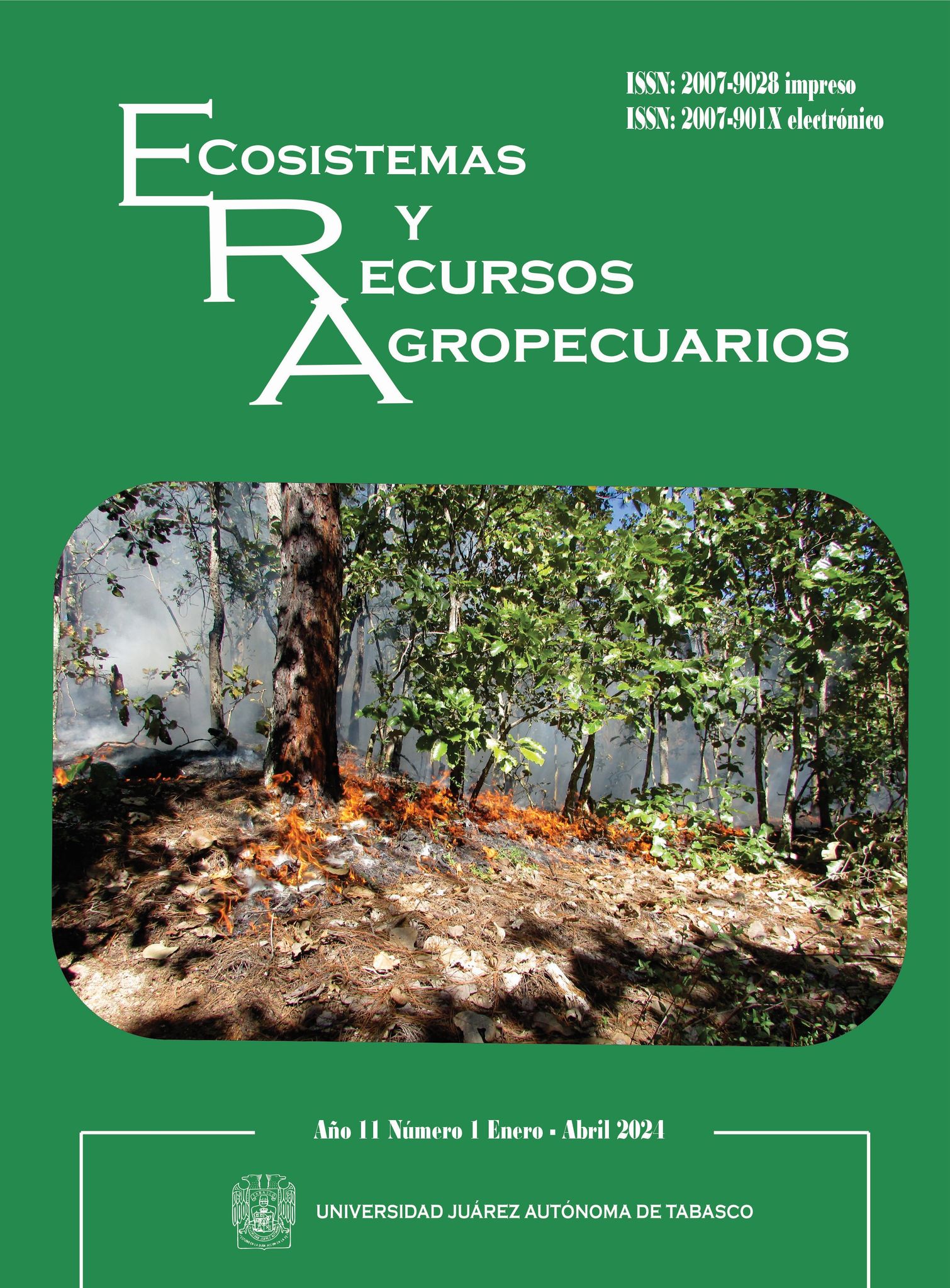Application and simulation of a prescribed burn in an oak-pine forest in Guerrero, México
DOI:
https://doi.org/10.19136/era.a11n1.3890Keywords:
flame height, wind speed, stem scar, forest fuelsAbstract
Standardized fuel models are a useful tool to predict fire behavior and propose forest fire suppression strategies. The aim was to compare the simulations of fire behavior with the result of a prescribed burn in an oak-pine forest in Guerrero, Mexico. Leaf litter (Ho), and mulch (Ma) samples were collected in 0.09 m2 at the end of the planar intersection lines for woody fuel sampling. The simulations in the FUEGO system were based on: a) field fuel loads, and b) theoretical loads of models 8 and 9. During the development of the burning, the temperature (T), relative humidity (HR), speed of the wind (VV), flame height (ALL) and fire spread speed (VP). The fuel load of 11 t ha-1 led to a PV = 1.07 m min-1 and ALL = 0.65 m for burning against the slope. The simulations with a mean square error (CME) of 0.11 showed acceptable values of ALL (0.54 and 0.64 m) except for the ALL-M8 model with 0.24 m (p < 0.05). The VP-real did not present statistical diferences with the simulations for values of 0.40 and 1.78 m with a CME = 0.54 and 1.56, the VP-9 and VP-M9 models provided high simulation values compared to the VP-M8 (p < 0.05). Fire behavior responded to changes in HR, VV and spatial distribution of fuels in the field.
Downloads
References
Anderson HE (1982) Aids to determining fuel models for estimating fire behavior. In USDA Forest Service general technical report INT - Intermountain Forest and Range Experiment Station, 122. Ogden: USDA Forest Service. 22p.
Andrews PL (2018) The Rothermel surface fire spread model and associated developments: A comprehensive explanation. General Technical Report. RMRS-GTR-371. Fort Collins, CO: U.S. Department of Agriculture, Forest Service, Rocky Mountain Research Station. 121p.
Andrews PL (2014) Current status and future needs of the BehavePlus fire modeling system. International Journal of Wildland Fire 23:21-33.
Batista AC, Beutling A, Pereira JF (2013) Fire vehavior evaluation in experimental fires on forest fuels of Pinus elliottii plantations. Revista Árvore 37(5):779-787.
Bernardo-Quissindo IA (2018) Estimación del comportamiento del fuego en quemada controlada en la hacienda experimental de Ngongoinga (Huambo, Angola). Revista Digital de Medio Ambiente “Ojeando la Agenda” 54: 60-76.
Bonilla-Padilla E, Rodríguez-Trejo DA, Borja de la Rosa A, Cíntora-González C, Santillán-Pérez J (2012) Dinámica de combustibles en rodales de encino-pino de Chignahuapan, Puebla. Revista Mexicana de Ciencias Forestales 4(19): 21-33.
Brown JK (1974) Handbook for inventorying downed woody material. Gen. Tech. Rep. INT-16. Ogden, UT: US Department of Agriculture, Forest Service, Intermountain Forest and Range Experiment Station. 16: 24 p.
Calleja-Peláez B, López-López B, Méndez-González J, Ríos Camey JM, Gutiérrez Merino E (2020) Tamaño de muestra para estimar cargas de combustible en bosque de encino en la región Montaña de Guerrero. Revista Mexicana de Ciencias Forestales 11(57): 174-195.
Cruz MG, Fernandes PM (2008) Development of fuel models for fire behaviour prediction in maritime pine (Pinus pinaster Ait.) stands. International Journal of Wildland Fire, 17(2): 194-204.
Grosse-Werner H (2009) Silvicultura del bosque nativo chileno. Función histórica y opciones futuras sobre la base de manejo sustentable. INFOR. Santiago de Chile. 136 P.
Flores-Garnica JG (2023) Simulación de las variaciones de la velocidad de propagación del fuego, durante una quema prescrita. e-CUCBA. 19:45-55.
Flores-Garnica JG, Rosas-Aceves OG, Ortega-Minakata AT, Rodríguez Chávez OG, Chávez-Duran ÁA Xelhuantzi-Carmona J (2011) Monitoreo del comportamiento del fuego en quemas prescritas. Campo Experimental Centro Altos de Jalisco, CIRPAC, INIFAP. Folleto Técnico No. 3. Tepatitlán, Jalisco. México. 69p.
Flores-Garnica JG y Gómez-Murillo LP (2011) Estimación práctica de la variabilidad de la humedad de combustibles bajo diferentes ecosistemas forestales. Revista Mexicana de Ciencias Forestales. 2(5): 45-57.
Flores-Garnica JG, Xelhuantzi-Carmona J, Chávez-Duran ÁA (2010) Monitoreo del comportamiento del fuego en una quema controlada en un rodal de pino-encino. Revista Chapingo, Serie Ciencias Forestales y del Ambiente 16(1): 49-59.
Fujioka FM, Gill AM, Viegas DX, Wotton M (2008) Fire danger and fire behavior modeling systems in Australia, Europe, and North America. Developments in Environmental Science 8: 471-497.
INEGI (2006) Conjunto de datos vectoriales, escala 1: 1 000 000. Precipitación media anual. Instituto Nacional de Estadística, Geografía e Informática. https://www.inegi.org.mx/app/biblioteca/ficha.html?upc=702825267544. Fecha de consulta 2 de enero de 2023.
INEGI (2007) Conjunto de datos vectoriales, escala 1: 1 000 000. Temperatura media anual. Instituto Nacional de Estadística, Geografía e Informática. https://www.inegi.org.mx/app/biblioteca/ficha.html?upc=702825267551. Fecha de consulta 2 de enero de 2023.
INEGI (2008) Conjunto de datos vectoriales, escala 1: 1 000 000. Unidades Climáticas. Instituto Nacional de Estadística, Geografía e Informática. https://www.inegi.org.mx/app/biblioteca/ficha.html?upc=702825267568. Fecha de consulta 2 de enero de 2023.
Islas-Madrid GE, Rodríguez-Trejo DA, Martínez-Hernández PA (2013) Diversidad del sotobosque y radiación solar en un bosque de Pinus hartwegii Lindl. con quema prescrita. Revista mexicana de ciencias forestales 4(15): 25-40.
Labenski P, Ewald M, Schmidtlein S, Ewald FF (2022) Classifying surface fuel types based on forest stand photographs and satellite time series using deep learning. International Journal of Applied Earth Observation and Geoinformation 109: 1-17. DOI:101016/jjag2022102799.
López-Moctezuma MÁ, Rodríguez-Trejo DA, Santiago-Cortés F, Sereno-Chávez A, y Granados-Sánchez D (2015) Tolerancia al fuego en Quercus magnoliifolia. Revista Árvore 39(3): 523-533.
Martínez-Becerra LW, Ramos-Rodríguez MP, Castillo-Martínez I, Bonilla-Vichot M, Sotolongo-Sospedra R (2004). Efectos de quemas prescritas sobre las propiedades del suelo en bosques de Pinus tropicalis Morelet, en Cuba. Revista Chapingo. Serie Ciencias Forestales y del Ambiente, 10(1):31-35.
National Wildfire Coordinating Group (2022). Glossary. https://www.nwcg.gov/ term/glossary/one-hour-timelag-fuels. Fecha de consulta 15 de febrero de 2022.
Pérez-Salicrup DR, Ortiz-Mendoza R, Garduño-Mendoza E, Martínez-Torres HL, Oceguera-Salazar KA, Quintero-Gradilla S, Castillo-Navarro F, Alvarado-Celestino E, González-Cabán A (2018) Coordinación institucional para la realización de quemas prescritas y quemas controladas en México. Revista Mexicana de Ciencias Forestales 9 (49): 253-270.
Ramos-Rodríguez MP, Albán-Ventura DO, Jiménez-González A, Mero-Jalca OF, Ganchozo-Quimis MT (2018) Planificación de una quema prescrita en una plantación de Tectona grandis Linn F. Revista Cubana de Ciencias Forestales 6(2): 184-194.
Ramos-Rodríguez MP, Pico-Coronel OG, Jiménez-González A, Cantos-Cevallos CG, Tapia-Zúñiga MV, Mero-Jalca OF (2019) Comportamiento del fuego a escala temporal experimental en una plantación de Tectona grandis L.f. en Jipijapa, Manabí, Ecuador. Revista Brasileira de Ciências Agrárias 14(1) :1-9.
Rodríguez-Trejo DA, Martínez-Muñoz P, Pulido-Luna JA, Martínez-Lara PJ, Cruz-López JD (2020) Combustibles, comportamiento del fuego y emisiones en un pastizal y una sábana artificiales en Chiapas, México. Revista de Biología Tropical 68(2): 641-654.
Rodríguez-Trejo DA, Pulido-Luna JA, Martínez-Muñoz P, Martínez-Lara PJ, Monjarás-Vega NA (2018) Análisis comparativo de quemas prescritas aplicadas a encinares tropicales. Agrociencia 52(6):783-801.
Ruíz-González AD (2009) Introducción al comportamiento del fuego. Recursos Rurais 5: 15-19.
SEMARNAT (2009) Norma Oficial Mexicana NOM-015-SEMARNAT/SAGARPA-2007, que establece las especificaciones técnicas de métodos de uso del fuego en los terrenos forestales y en los terrenos de uso agropecuario. Diario Oficial de la Federación. 16 de enero de 2009. México, D.F., México. http://www.profepa.gob.mx/innovaportal/file/3331/1/nom-015-semarnatsagarpa- 2007.pdf. Fecha de consulta 2 de febrero de 2023.
SPSS (2011) IBM SPSS Statistics for Windows.Version 20.0. IBM Corp.New York, NY USA. n/p.
Scholl ER, Waldrop TA (1999) Photos for estimating fuel loadings before and after prescribed burning in upper coastal plain of the southeast. General Technical Report SRS-26. Southern Research Station. USDA Forest Service. 25 p.
Scott JH, Burgan RE (2005) Standard fire behavior fuel models: a comprehensive set for use with Rothermel’s surface fire spread model. Gen. Tech. Rep. RMRSGTR-153. Fort Collins, CO: U.S. Department of Agriculture, Forest Service, Rocky Mountain Research Station 72 p.
Tricone F, Anderson TR (2018) Guía para Modelos de Combustible de Comportamiento de Fuego en Ecosistemas Tropicales. Sarteneja, Belize, 31 p.
Urrutia-Hernández I, Rodríguez Alfaro B, González Menéndez M, Martínez Becerra LW, Flores Garnica JG, Alonso Torrens Y (2020) Impacto de quemas prescritas en la estabilidad del escurrimiento superficial en un bosque de pino. Madera y bosques 26(2):1-12.
Downloads
Published
Issue
Section
License
Copyright (c) 2024 Ecosistemas y Recursos Agropecuarios

This work is licensed under a Creative Commons Attribution-NonCommercial-ShareAlike 4.0 International License.
Aviso de copyright
Los autores que se envían a esta revista aceptan los siguientes términos:
una. Los autores conservan los derechos de autor y garantizan a la revista el derecho a ser la primera publicación del trabajo con una licencia de atribución de Creative Commons que permite a otros compartir el trabajo con un reconocimiento de la autoría del trabajo y la publicación inicial en esta revista.
B. Los autores pueden establecer acuerdos complementarios separados para la distribución no exclusiva de la versión del trabajo publicado en la revista (por ejemplo, en un repositorio institucional o publicarlo en un libro), con un reconocimiento de su publicación inicial en esta revista.
C. Se permite y se anima a los autores a difundir su trabajo electrónicamente (por ejemplo, en repositorios institucionales o en su propio sitio web) antes y durante el proceso de envío, ya que puede conducir a intercambios productivos, así como a una cita más temprana y más extensa del trabajo publicado. (Consulte El efecto del acceso abierto).


